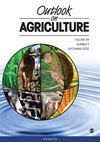Technology, infrastructure and enterprise trade-off: Strengthening smallholder farming systems in Tamil Nadu State of India for sustainable income and food security
IF 2.6
3区 经济学
Q1 AGRICULTURE, MULTIDISCIPLINARY
引用次数: 1
Abstract
The complexities of smallholder farming systems pose a challenge in demonstrating the potential benefits or risks of new technologies and policies. Using Integrated Analysis Tool, a rule-based dynamic simulation model, this study tried to improve the performance of major farming systems in the Tamil Nadu State of India. Amongst the four major farming systems viz. Black gram-based (BFS), Paddy-based (PFS), and Integrated Farming Systems (IFS) in Villupuram district and Dryland Farming System (DFS) in Virudhunagar district, IFS was found to be the most profitable and resilient based on their performance simulated for a 3-year rotation. Setting IFS as a benchmark, potential interventions were evaluated under other farming systems to improve their relative performance. The analysis allowed understanding the interactions in smallholder farming systems and the potential impact of interventions in a whole farm way considering the cash flows, cost intensity, and input-output trade-offs. While multi-bloom technology in black gram increased the net profit of BFS without much stress on input and labour, area expansion under rainfed groundnut incurred high expenditure. Trading-off paddy with maize and groundnut significantly increased the net profit of PFS but replacing sugarcane with tapioca and turmeric was not remunerative. Improved livestock management practices have substantially increased the net profit of DFS wherein crop yield could not be enhanced substantially without the prospects of good irrigation infrastructure. The irrigation endowed PFS has achieved 90% performance, whereas the water-starved BFS and DFS could achieve only 65% performance of IFS. We conclude that agricultural policy must not only focus on potential interventions that are profitable but also consider what is acceptable to the farmer, considering synergies and trade-offs between competing resources at the farm level.技术、基础设施和企业权衡:加强印度泰米尔纳德邦小农农业系统,促进可持续收入和粮食安全
小农户农业系统的复杂性对证明新技术和政策的潜在好处或风险构成了挑战。本研究使用基于规则的动态模拟模型综合分析工具,试图提高印度泰米尔纳德邦主要农业系统的性能。在四大农业系统中,即Villupuram区的黑克(BFS)、水稻(PFS)和综合农业系统(IFS),以及Virudhunagar区的旱地农业系统(DFS),根据其3年轮作的模拟表现,IFS被发现是最有利可图和最具弹性的。以IFS为基准,在其他农业系统下评估了潜在的干预措施,以提高其相对绩效。该分析使我们能够了解小农户农业系统中的相互作用,以及考虑现金流、成本强度和投入产出权衡的整个农场干预措施的潜在影响。在不增加投入和劳动力的情况下,黑克多花技术提高了BFS的净利润,而在旱地花生下扩大面积则产生了较高的支出。用玉米和花生换水稻显著增加了PFS的净利润,但用木薯和姜黄代替甘蔗没有回报。牲畜管理实践的改进大大提高了DFS的净利润,如果没有良好的灌溉基础设施,作物产量就无法大幅提高。灌溉条件下的PFS达到了90%的性能,而缺水的BFS和DFS只能达到IFS的65%的性能。我们得出的结论是,农业政策不仅必须关注有利可图的潜在干预措施,还必须考虑农民可以接受的措施,考虑农场一级竞争资源之间的协同作用和权衡。
本文章由计算机程序翻译,如有差异,请以英文原文为准。
求助全文
约1分钟内获得全文
求助全文
来源期刊

Outlook on Agriculture
农林科学-农业综合
CiteScore
5.60
自引率
13.30%
发文量
38
审稿时长
>36 weeks
期刊介绍:
Outlook on Agriculture is a peer reviewed journal, published quarterly, which welcomes original research papers, research notes, invited reviews and commentary for an international and interdisciplinary readership. Special attention is paid to agricultural policy, international trade in the agricultural sector, strategic developments in food production, the links between agricultural systems and food security, the role of agriculture in social and economic development, agriculture in developing countries and environmental issues, including natural resources for agriculture and climate impacts.
 求助内容:
求助内容: 应助结果提醒方式:
应助结果提醒方式:


